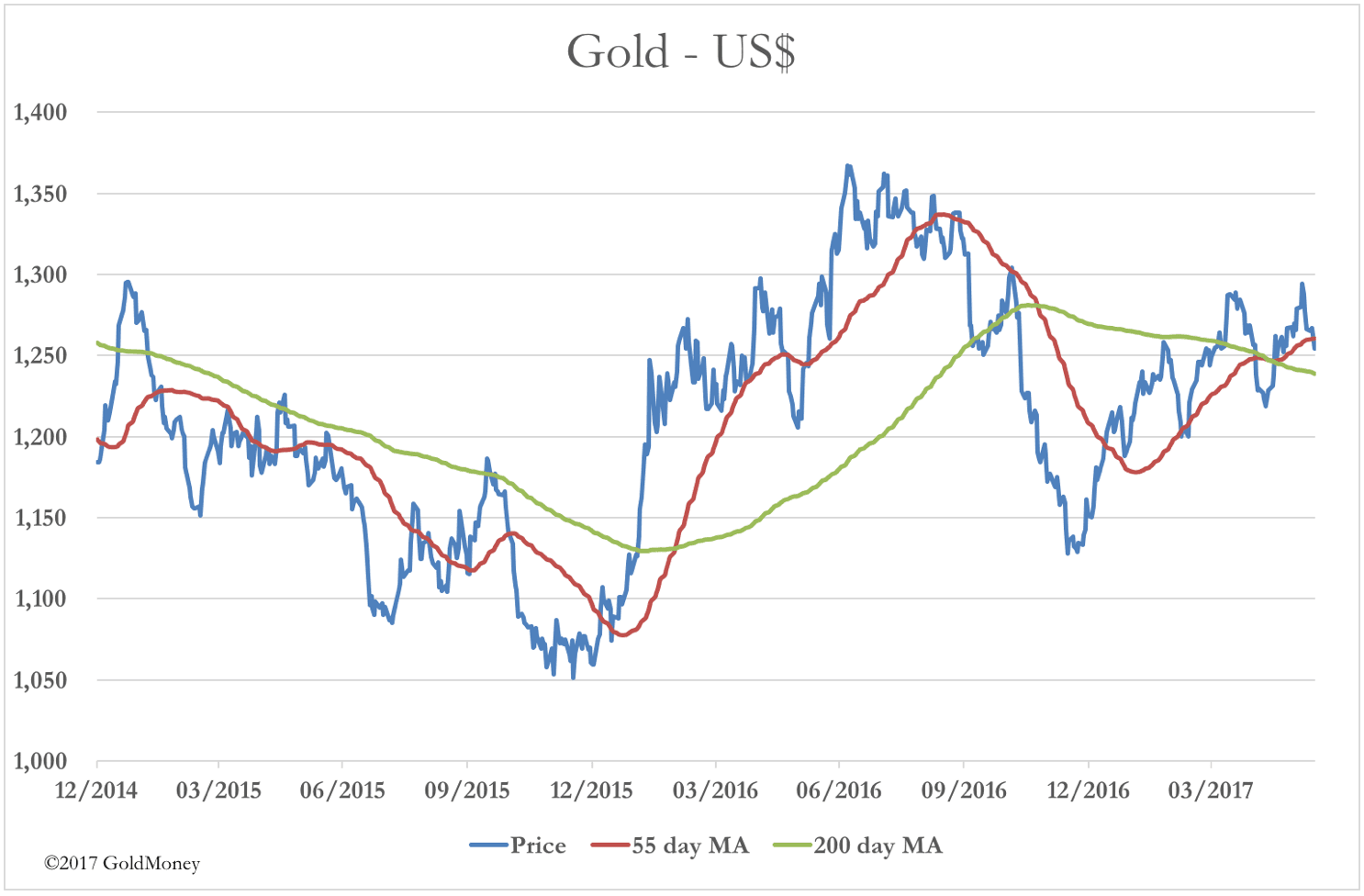Market Report: Rate rise, stronger dollar, weak gold
Jun 16, 2017·Alasdair MacleodThis week, the Fed’s FOMC increased the Fed funds rate by 0.25%, to a target of 1% to 1.25%. This was so certain to happen it was fully discounted in the markets. The FOMC also gave some details about its aspirational plans to reduce its balance sheet over time. Nonetheless, the dollar rallied, helping to push gold and silver lower.
Having backed off from last week’s challenge of the $1300 level, gold fell a further $13 this week to $1254 in early morning trade in Europe this morning. Silver fell a further 44 cents over the same time scale.
Technical traders noted gold falling back to test its 55-day moving average, and failing to find support there, at $1260, following the FOMC decision. This is our next chart.
Seasoned chartists would say it’s too early to say this pull-back has caused significant technical damage, but they will be watching the momentum of the 55-day MA, only getting concerned if it turns downwards from its current flat trajectory. In short, they would like to see some support for the price, perhaps in the $1248-1250 region.
This move must not be regarded as unusual. The bullion banks have been trying to reduce their shorts, and part of that is news management, as well as deploying the firepower to take out speculator’s stops. We see this time and time again, and here it could be that the end of this month is important. Often in the past, we have seen gold prices fall into June, only to bottom out and rally strongly afterwards. It is not over-cynical to ascribe this to half-yearly accounting, when futures and options are marked-to-market. Bullion banks, all at the same time, need to see lower prices for their shorts in the derivative markets, and they adept at achieving it.
This reminds us of two things. First, prices are heavily managed on a cyclical basis through futures markets, and secondly, we should note that after the end of the month this effect will have gone.
Of course, the bullion banks don’t have it all their way, because if they push prices too low, demand for physical bullion increases, straining their delivery schedules. We see this reflected in the exchange for physical numbers (EFP) on Comex. As the price of gold fell, this rose from the 3,500 level to 8,922 on Wednesday, and 14,284 yesterday. The terms of the EFPs are not revealed, and can reflect several things. But the message is clear: 27.75 tonnes walked out of the door on Wednesday, and a further 44.43 tonnes yesterday. This is a serious and ongoing strain on the paper system, and suggests that futures prices should rise in the short-term to reduce this drain.
Speculation in crypto-currencies has reached fever-pitch. It really is the Madness of Crowds on a global scale, with more crypto-currencies now registered (753) than government currencies (177), according to CoinMarketCap. This is setting up for a crash of major proportions, so much so it could spill over into other areas.
The views and opinions expressed in this article are those of the author(s) and do not reflect those of Goldmoney, unless expressly stated. The article is for general information purposes only and does not constitute either Goldmoney or the author(s) providing you with legal, financial, tax, investment, or accounting advice. You should not act or rely on any information contained in the article without first seeking independent professional advice. Care has been taken to ensure that the information in the article is reliable; however, Goldmoney does not represent that it is accurate, complete, up-to-date and/or to be taken as an indication of future results and it should not be relied upon as such. Goldmoney will not be held responsible for any claim, loss, damage, or inconvenience caused as a result of any information or opinion contained in this article and any action taken as a result of the opinions and information contained in this article is at your own risk.
